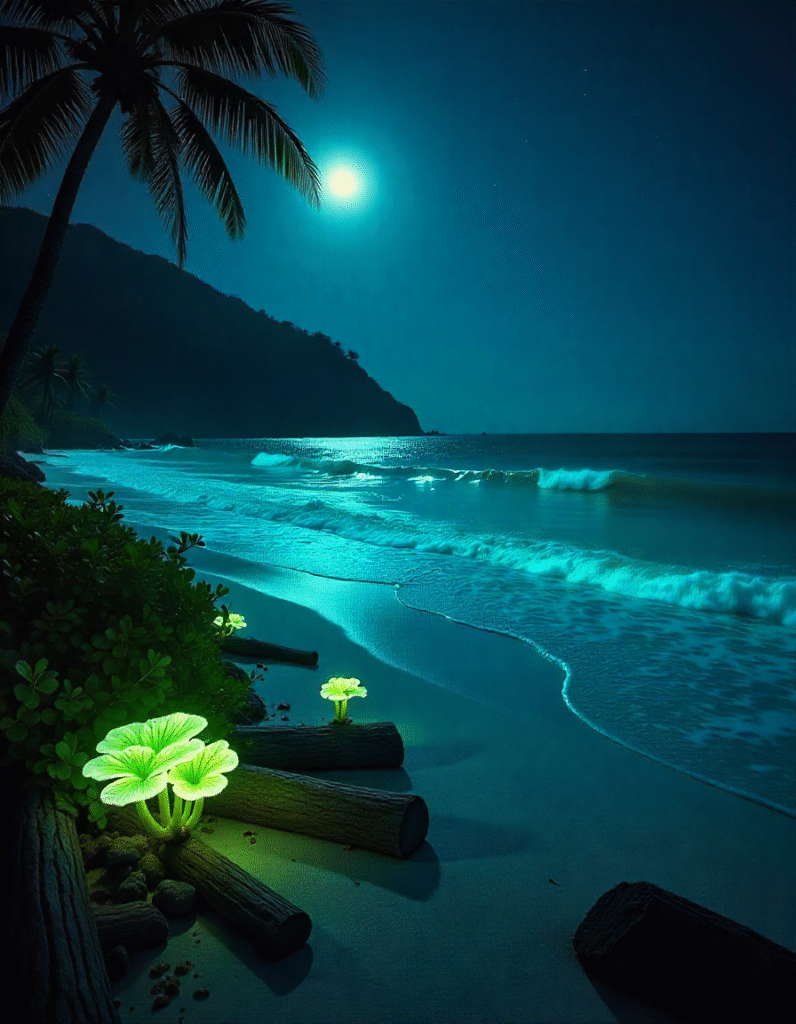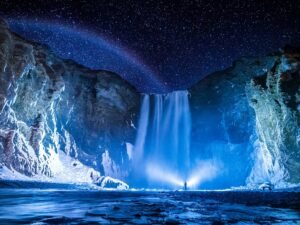In the quiet depths of the ocean, where sunlight barely reaches, a dazzling display of light unfolds. Creatures like the Hawaiian bobtail squid and the deep-sea anglerfish create their own glow, illuminating the darkness with an ethereal shimmer. This phenomenon, known as bioluminescence, is one of nature’s most captivating spectacles. Far from being limited to the sea, bioluminescence appears in forests, caves, and even open fields, where fireflies dance under summer skies. But what exactly is bioluminescence, why does it exist, and what can it teach us about the natural world?
The Science Behind the Glow
Bioluminescence occurs when living organisms produce light through a chemical reaction. At its core, this process involves a molecule called luciferin, which, when combined with oxygen and catalyzed by an enzyme called luciferase, emits light. This reaction is remarkably efficient, producing almost no heat, unlike the incandescent bulbs we use. The light emitted can range from blue to green, and occasionally red, depending on the organism and the chemical makeup of its luciferin.
This ability has evolved independently across a wide range of species, from single-celled dinoflagellates to complex vertebrates like fish. Scientists estimate that bioluminescence has developed at least 40 separate times in evolutionary history, a testament to its usefulness. Each species uses this light for different purposes, shaped by the unique pressures of their environments.
Bioluminescence in the Ocean
The ocean is the epicenter of bioluminescence, where the majority of glowing organisms reside. In the pitch-black depths, light becomes a tool for survival. Take the anglerfish, a creature straight out of a science fiction novel. It dangles a glowing lure, formed by bioluminescent bacteria, to attract curious prey in the deep sea. The light is a deadly trap, drawing victims close enough to be swallowed whole.
Other marine creatures, like the Hawaiian bobtail squid, use bioluminescence for camouflage. The squid hosts a colony of bioluminescent bacteria in a special organ beneath its body. These bacteria emit a soft glow that matches the moonlight filtering through the water above, erasing the squid’s shadow and making it nearly invisible to predators below. This strategy, called counter-illumination, is a brilliant example of nature’s ingenuity.
Dinoflagellates, microscopic plankton, create some of the most breathtaking displays of bioluminescence. When disturbed by waves or a passing boat, they light up, turning coastal waters into a glowing canvas. Places like Mosquito Bay in Puerto Rico or the Maldives’ bioluminescent beaches draw visitors from around the world to witness this natural wonder. The glow serves as a defense mechanism, startling predators or attracting larger animals that might eat the threat.
On Land: Fireflies and Fungi
While the ocean hosts the most bioluminescent species, land is not without its own glowing wonders. Fireflies, or lightning bugs, are perhaps the most familiar. On warm summer evenings, their flickering lights create a magical scene in meadows and forests. Male fireflies use specific flash patterns to attract mates, each species with its own unique signal. A female, perched on a blade of grass, might respond with her own flash if she deems the suitor worthy. This silent conversation of light is both a courtship ritual and a way to avoid predators, who may associate the glow with unpalatable chemicals.
Less well-known are bioluminescent fungi, often called “foxfire” or “fairy fire.” Found in decaying wood in temperate and tropical forests, these mushrooms emit a soft green glow. The purpose of this light is still a mystery, though some researchers believe it attracts insects that help spread fungal spores. Walking through a forest at night and stumbling upon a glowing log feels like stepping into a fairy tale, a reminder of how much remains unknown about the natural world.
Evolutionary Advantages
Why do so many organisms go to the trouble of producing light? The answer lies in survival. In the ocean, bioluminescence serves multiple roles: communication, camouflage, attraction, and defense. For example, some squid species release a cloud of glowing ink to confuse predators, much like a smoke screen. Others, like certain jellyfish, flash brightly when attacked, potentially startling or exposing the predator to larger threats.
On land, fireflies use their glow to find mates, but the light can also deter predators. Many firefly species produce toxic chemicals, and their glow serves as a warning, much like the bright colors of a poison dart frog. In fungi, the glow might aid in spore dispersal, though this is still speculative. What’s clear is that bioluminescence offers a significant advantage, or it wouldn’t have evolved so many times across such diverse species.
Cultural and Historical Significance
Bioluminescence has long captured human imagination. Sailors in ancient times told tales of glowing seas, attributing them to spirits or gods. The term “luciferin” itself comes from the Latin word for “light-bearer,” hinting at the almost mystical quality of this phenomenon. In folklore, glowing fungi were often associated with the supernatural, guiding lost travelers or marking hidden treasures.
In modern times, bioluminescence has inspired art, literature, and even technology. The glowing beaches of the Maldives have become a bucket-list destination, while firefly festivals in Japan and the United States draw thousands of visitors. Writers like Jules Verne incorporated bioluminescent creatures into their stories, evoking the wonder of the unknown. Today, scientists study bioluminescence not just for its beauty but for practical applications, from medical imaging to energy-efficient lighting.
Applications in Science and Technology
The study of bioluminescence has led to remarkable breakthroughs. Luciferase, the enzyme behind the glow, is widely used in biomedical research. Scientists attach luciferase genes to other organisms or cells to track biological processes, such as the spread of cancer or the activity of certain genes. This technique, known as bioluminescent imaging, allows researchers to observe living systems in real time without invasive procedures.
Bioluminescence also inspires sustainable technology. The efficiency of the luciferin-luciferase reaction, which produces light with minimal energy loss, has prompted researchers to explore its potential for eco-friendly lighting. While we’re far from replacing streetlights with glowing bacteria, the concept highlights how nature can guide innovation. Some scientists are even experimenting with bioluminescent plants, imagining a future where trees could softly illuminate city streets.
Conservation Challenges
Despite its beauty, bioluminescence faces threats from human activity. Light pollution, particularly in coastal areas, can drown out the glow of fireflies and marine organisms, disrupting their behavior. For fireflies, habitat loss due to urbanization and pesticide use has led to declining populations in many regions. In the ocean, climate change and pollution threaten bioluminescent species like dinoflagellates, which are sensitive to changes in water temperature and chemistry.
Conservation efforts are underway to protect these glowing wonders. In Puerto Rico, Mosquito Bay is a protected site, with strict regulations on boat traffic and artificial lighting. Firefly sanctuaries in places like Japan and the Great Smoky Mountains in the United States aim to preserve habitats and educate the public. These efforts remind us that preserving bioluminescence is not just about saving a spectacle but about maintaining the delicate balance of ecosystems.
A Window into Nature’s Creativity
Bioluminescence is more than a quirky trait of certain creatures; it’s a window into the creativity and adaptability of life. From the depths of the ocean to a quiet forest clearing, these glowing organisms reveal how evolution solves problems in unexpected ways. They remind us that even in the darkest places, life finds a way to shine.
For those lucky enough to witness bioluminescence—whether it’s a firefly’s flicker or the glowing waves of a tropical bay—the experience is unforgettable. It’s a call to marvel at the world around us, to protect its wonders, and to keep exploring the mysteries that still lie hidden in nature’s glow.





